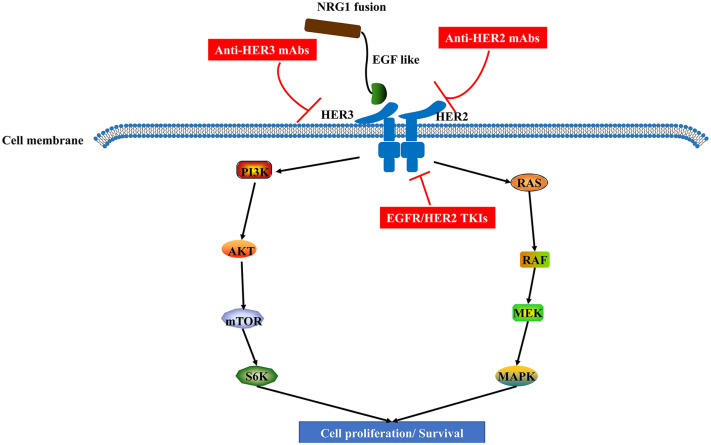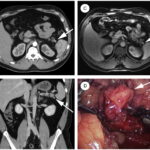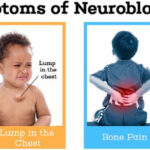Neuregulin 1 gene fusion positive non small cell lung cancer (NRG1+ NSCLC) is a rare molecular subtype of NSCLC that involves the fusion of the NRG1 gene with various partner genes. This fusion leads to aberrant signaling in the HER3 (ERBB3) pathway, contributing to uncontrolled tumor growth and progression. Although NRG1 fusions are found in only about 0.2% of NSCLC cases, they represent a distinct target for precision oncology.
NRG1+ NSCLC is often non-smoking-associated, more prevalent in lung adenocarcinoma, and presents unique therapeutic challenges due to resistance to standard therapies like EGFR and KRAS inhibitors. Targeted therapy and clinical trials are emerging as potential solutions for patients with this rare lung cancer subtype.

Molecular Mechanism and Pathophysiology of neuregulin 1 gene fusion positive non small cell lung cancer
1. Role of the Neuregulin 1 (NRG1) Gene
The NRG1 gene encodes ligands that activate the HER3 receptor, which in turn interacts with HER2 and other HER family receptors, promoting cancer cell proliferation, survival, and metastasis.
2. Mechanism of NRG1 Fusion in NSCLC
In NRG1+ NSCLC, chromosomal rearrangements cause the NRG1 gene to fuse with various partner genes, leading to constitutive HER3 activation, independent of ligand binding.
3. Key NRG1 Fusion Partners in NSCLC
NRG1 fusions occur with multiple partner genes, influencing tumor behavior and therapeutic response.
- CD74-NRG1 (most common in lung cancer)
- SLC3A2-NRG1
- ATP1B1-NRG1
- VAMP2-NRG1
These fusions are frequently associated with mucinous adenocarcinoma, a poorly differentiated subtype of lung cancer.
Epidemiology and Risk Factors
- Prevalence: 0.2% of NSCLC cases (~1 in 500 patients).
- Most Common in: Lung adenocarcinoma, but also found in pancreatic and colorectal cancers.
- Risk Factors:
- Non-smoking status (many cases occur in never-smokers).
- Genetic predisposition (rare familial lung cancer syndromes).
- Previous exposure to environmental carcinogens.
Clinical Presentation and Symptoms: Neuregulin 1 Gene Fusion Positive Non-Small Cell Lung Cancer
NRG1+ NSCLC presents similarly to other forms of advanced lung cancer, but certain features stand out.
1. General Symptoms of Neuregulin 1 Gene Fusion Positive Non-Small Cell Lung Cancer
- Persistent cough and breathlessness
- Unintentional weight loss
- Fatigue and weakness
- Chest pain or tightness
2. Unique Features of NRG1+ NSCLC
- Lower smoking history among patients
- More frequent in mucinous adenocarcinoma subtypes
- Often diagnosed at later stages due to lack of early symptoms
Diagnostic Strategies for NRG1+ NSCLC
1. Molecular Testing for NRG1 Fusions
Standard diagnostic methods for NRG1+ NSCLC include:
| Diagnostic Test | Methodology | Advantages |
|---|---|---|
| Next-Generation Sequencing (NGS) | DNA or RNA sequencing of tumor samples | Most comprehensive molecular profiling |
| Fluorescence In Situ Hybridization (FISH) | Identifies chromosomal rearrangements | Confirms NRG1 fusion presence |
| Reverse Transcriptase PCR (RT-PCR) | Detects specific fusion transcripts | High sensitivity for known fusions |
2. Imaging Modalities
- CT scan and PET scan to assess tumor spread.
- MRI for brain metastases, as NSCLC has a high tendency for central nervous system (CNS) involvement.
Current and Emerging Treatment Options
1. Standard Therapies and Their Limitations
NRG1+ NSCLC does not respond well to conventional therapies:
- EGFR and ALK inhibitors are ineffective due to HER3-driven resistance.
- Chemotherapy provides only limited benefit.
- Immunotherapy (PD-1/PD-L1 inhibitors) shows poor response rates.
2. Targeted Therapy for NRG1+ NSCLC
Several HER3-targeted therapies are in clinical trials to improve treatment outcomes.
| Drug | Mechanism | Current Status |
|---|---|---|
| Zenocutuzumab (MCLA-128) | Dual HER2/HER3 inhibitor | Phase 2 trials |
| Seribantumab | HER3 monoclonal antibody | Phase 2 trials |
| Afatinib | Pan-HER inhibitor (HER1, HER2, HER3) | Off-label use |
3. Future Treatment Strategies
- HER3-ADC (antibody-drug conjugates) under development.
- Combination therapies with HER2 inhibitors to block dimerization effects.
Prognosis and Survival Outcomes
| Factor | Impact on Prognosis |
|---|---|
| NRG1 fusion subtype | Some variants may respond better to therapy |
| Tumor stage at diagnosis | Late-stage cases have worse survival |
| Treatment access | Clinical trial participation improves outcomes |
Patients receiving HER3-targeted therapy show promising results, but further long-term studies are needed.
Ongoing Clinical Trials and Research
Several clinical trials are actively recruiting patients for NRG1+ NSCLC therapies.
- Zenocutuzumab (MCLA-128) Phase 2 trial
- Seribantumab HER3 inhibitor study
- HER3-ADC experimental trials
Neuregulin 1 gene fusion-positive NSCLC is a rare but significant molecular subtype that poses unique diagnostic and treatment challenges. With advances in targeted therapy, particularly HER3 inhibitors, there is growing hope for improved outcomes in NRG1+ NSCLC patients. Ongoing clinical trials and genomic research will play a crucial role in refining treatment strategies for this rare lung cancer subtype.

